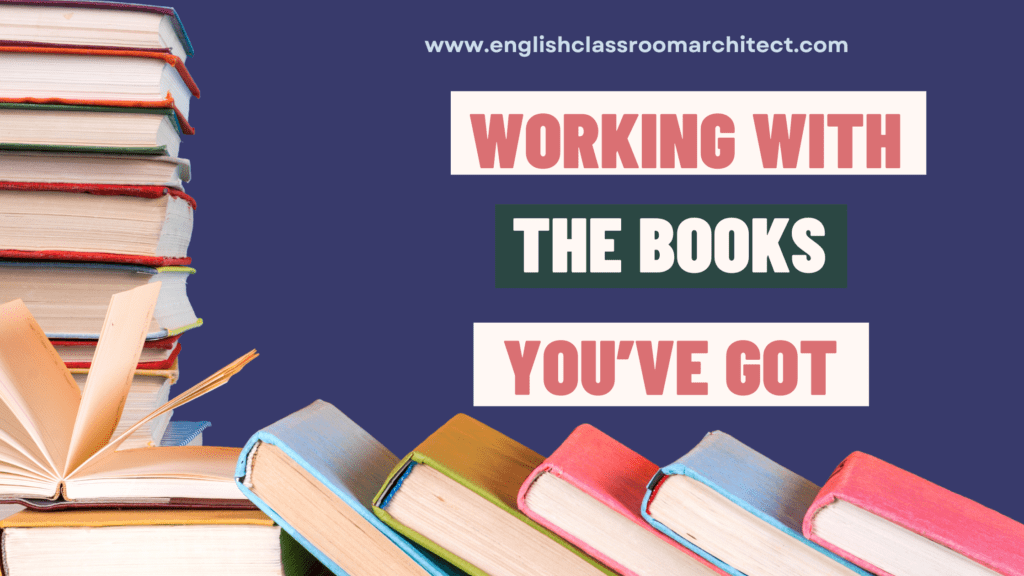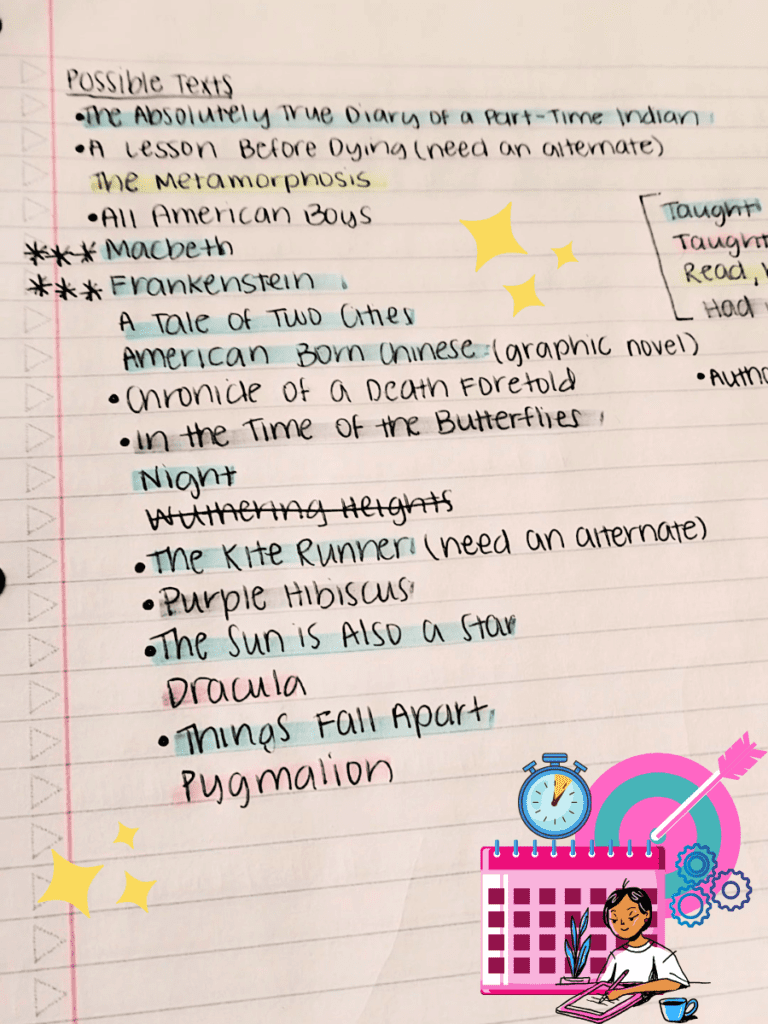Wouldn’t it be great to have a magical, unlimited department, filled with class sets of diverse, engaging (and approved) texts that perfectly align with our curriculum goals? The reality, however, is often quite different. In my case, for my English 10 books, I’m working with a book room that’s heavy on the classics. But constraints breed creativity, right? Let’s dive into how I’m approaching text selection and thematic unity for my English 10/10 Honors curriculum revamp. While I am switching up both levels, this post will focus on English 10 Honors.

Table of Contents
The Book Room Reality Check
My first step was to survey what I actually had available. My book room is a treasure trove of classics – think Steinbeck, Miller, and Shakespeare. For English 10 books, here’s what I have available:
- Sherman Alexie’s The Absolutely True Diary of a Part-Time Indian
- Ernest Gaines’ A Lesson Before Dying
- Franz Kafka’s The Metamorphosis
- Jason Reynolds’ and Brendan Kiely’s All American Boys
- William Shakespeare’s Macbeth
- Mary Shelley’s Frankenstein
- Charles Dickens’ A Tale of Two Cities
- Gene Luen Yang’s American Born Chinese
- Gabriel Garcia Marquez’s Chronicle of a Death Foretold
- Julia Alvarez’s In the Time of the Butterflies
- Elie Wiesel’s Night
- Emily Bronte’s Wuthering Heights
- Khaled Hosseini’s The Kite Runner
- Chimamanda Ngoza Adichie’s Purple Hibiscus
- Nicola Yoon’s The Sun is Also a Star
- Bram Stoker’s Dracula
- Chinua Achebe’s Things Fall Apart
- George Bernard Shaw’s Pygmalion
There is quite a bit there, but in my opinion it’s a little all over the place. So this is my process:
- What are the required texts (Macbeth for everyone and Frankenstein for my honors classes)?
- What have I taught (both successfully and unsuccessfully)?
- What have I read and not taught?
- What have I taught in literature circles?
Thematic Cohesion: The Glue That Binds
With my available texts in mind, I started looking for common threads. What themes run through these works? What do I want students to talk about? How can I connect them to create a cohesive journey for my students?
After much deliberation, I settled on the nature of knowledge as our umbrella for the year. This theme allows us to explore manipulation of information and how misinformation spreads, academic integrity with increasing access to generative AI, how action and inaction are related to the information we have, and where knowledge is held and how that relates to individual and collective responsibility.
One I went through this list, I settled on:
- Whole class texts of Macbeth, Frankenstein, graphic novel exploration (American Born Chinese, Persepolis, Maus), and Chronicle of a Death Foretold…I know Persepolis and Maus were not on my original list, but I know they are available in the book room, just not taught on this level recently)
- Literature circles (focus concept – storytelling): Dracula, Things Fall Apart, and In the Time of the Butterflies
- Short story unit of stories with twist endings
Some additional constraints for my English 10 books: Center a text by a non-white author. Incorporate book clubs.

When looking at book club books, I wanted to be sure that the books I chose could actually be read and comprehended by my students, so for my honors students I wanted the Lexile to be between 800 and 1000. That limited my choices to:
- Things Fall Apart by Chinua Achebe – 890L
- In the Time of the Butterflies by Julia Alvarez – 960L
- The Kite Runner by Khaled Hosseini – 840L
- Purple Hibiscus by Chimamanda Ngoza Adichie – 920L
- Dracula by Bram Stoker – 970L
If you’re familiar with all these books you know that the page lengths of these books vary wildly, so this will be something I need to consider when I get into the planning.
I’ve taught Purple Hibiscus in literature circles before and I felt like it didn’t really work as well as a more independent read. I’ve been wanting to do a storytelling unit and the remaining four work really well together for that topic, in my opinion.
I think all the remaining book club books will benefit from some specialized content, but since these are mostly books I taught as whole-class texts I have something to draw on.
So then my last criteria is centering a non-white author. What’s left is The Purple Hibiscus and Chronicle of Death Foretold. Chronicle is having a moment in my department, so I’m going to go with that one. It’s also short, so I think we can read it all together.
Up until the very moment I was writing this out I planned to teach A Tale of Two Cities instead of the graphic novels, but a couple things stopped me.
- Will it be worth it to spend the time needed to read the novel as compared to other texts?
- It was looking pretty British. I realized I could significantly increase the diversity in genre, author, and topic by including the graphic novels.
I presented book choice as a linear process, but for me it’s really more organic. I brainstormed what units might look and how units might fit together before settling in on the yearlong theme and then I went back to consider progression and reviewed for diversity.
Real-World Connections: Bringing It Home
To ensure these texts resonate with my students, I’m constantly on the lookout for real-world connections. Current events, pop culture, local issues, and student experiences all serve as potential links between our readings and the world outside our classroom. Did you know that Dracula found a resurgence during the pandemic when Matt Kirkland serialized it? I didn’t.
To bridge the gap between classic literature and contemporary issues, I’ve decided to incorporate film into my curriculum. This not only adds variety but also helps students draw connections between different forms of storytelling and analyze how themes persist across time and media. I have in mind incorporating The Prestige and The Sixth Sense as standalone units and clips of the What If…? Marvel series in my personal narrative unit. Also, if you know me, you know I live Beyonce, and I have in mind a concept album mini-unit with her most recent album, Cowboy Carter, which can work nicely with the storytelling unit.
Progression: Building Skills and Insights
As I arrange these texts and supplementary materials, I’m mindful of how they build upon each other. What skills will students develop with each text? How does each work deepen their understanding of our overarching theme?
Conclusion
Curriculum design, especially when working with limited resources, is a balancing act. As I continue this process, I’m excited to see how these pieces come together to create a meaningful, engaging experience for my students.
What’s your experience with curriculum design? How do you handle resource limitations in your school? Share your thoughts and tips in the comments below!
Interested in more ideas for building your curriculum? Check out Building an Energizing Curriculum Part 1 and Part 2.
